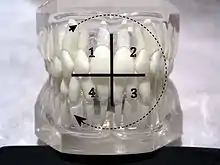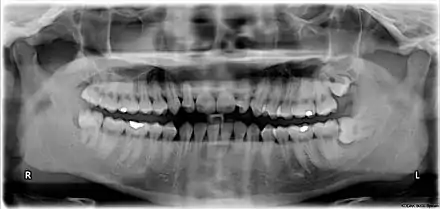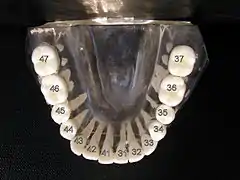FDI World Dental Federation notation
FDI World Dental Federation notation is a dental notation widely used by dentists internationally to associate information to a specific tooth.[1] In the form of the ISO Designation System, it is a current international standard by the code ISO 3950.[2]

The system is developed by the FDI World Dental Federation. It is also used by the World Health Organization, and is used in most countries of the world except the United States (which uses the UNS) and the United Kingdom (where the older Palmer Notation Method is used).
Orientation of the chart is traditionally "dentist's view", i.e. patient's right corresponds to notation chart left. The designations "left" and "right" on the chart below correspond to the patient's left and right.
Table of codes

| Permanent teeth | |||||||||||||||
|---|---|---|---|---|---|---|---|---|---|---|---|---|---|---|---|
| patient's upper right | patient's upper left | ||||||||||||||
| 18 | 17 | 16 | 15 | 14 | 13 | 12 | 11 | 21 | 22 | 23 | 24 | 25 | 26 | 27 | 28 |
| 48 | 47 | 46 | 45 | 44 | 43 | 42 | 41 | 31 | 32 | 33 | 34 | 35 | 36 | 37 | 38 |
| patient's lower right | patient's lower left | ||||||||||||||
| Deciduous teeth (baby teeth) | |||||||||||||||
| upper right | upper left | ||||||||||||||
| 55 | 54 | 53 | 52 | 51 | 61 | 62 | 63 | 64 | 65 | ||||||
| 85 | 84 | 83 | 82 | 81 | 71 | 72 | 73 | 74 | 75 | ||||||
| lower right | lower left | ||||||||||||||

Codes, names, and usual number of roots: (see chart of teeth at Universal Numbering System)
- 11 21 51 61 maxillary central incisor 1
- 41 31 81 71 mandibular central incisor 1
- 12 22 52 62 maxillary lateral incisor 1
- 42 32 82 72 mandibular lateral incisor 1
- 13 23 53 63 maxillary canine 1
- 43 33 83 73 mandibular canine 1
- 14 24 maxillary first premolar 2
- 44 34 mandibular first premolar 1
- 15 25 maxillary second premolar 1
- 45 35 mandibular second premolar 1
- 16 26 54 64 maxillary first molar 3
- 46 36 84 74 mandibular first molar 2
- 17 27 55 65 maxillary second molar 3
- 47 37 85 75 mandibular second molar 2
- 18 28 maxillary third molar 3
- 48 38 mandibular third molar 2
 ISO notation upper jaw
ISO notation upper jaw ISO notation lower jaw
ISO notation lower jaw ISO notation primary teeth
ISO notation primary teeth
How the codes are constructed
Syntax: <quadrant code><tooth code>
Sometimes a dot is inserted between quadrant code and tooth code in order to avoid ambiguity with other numbering systems, especially the UNS.
| 1 | upper right permanent teeth |
| 2 | upper left permanent teeth |
| 3 | lower left permanent teeth |
| 4 | lower right permanent teeth |
| 5 | upper right deciduous teeth |
| 6 | upper left deciduous teeth |
| 7 | lower left deciduous teeth |
| 8 | lower right deciduous teeth |
| This is set by going clockwise from the dentist's view. | |
| 1 | central incisors |
| 2 | lateral incisors |
| 3 | canines |
| 4 | 1st premolars (permanent teeth) / 1st molar (deciduous teeth) |
| 5 | 2nd premolars (permanent teeth) / 2nd molar (deciduous teeth) |
| 6 | 1st molars (permanent teeth) |
| 7 | 2nd molars (permanent teeth) |
| 8 | 3rd molars (permanent teeth) |
| This is defined by counting. | |
Examples:
- "13" = permanent upper right, 3rd tooth (canine)
- "32" = permanent lower left, 2nd tooth (lateral incisor)
References
- FDI Two-Digit Notation Archived 2007-04-01 at the Wayback Machine, hosted on the FDI World dental Federation website. Page accessed April 1, 2007.
- ISO 3950:2009 Dentistry — Designation system for teeth and areas of the oral cavity